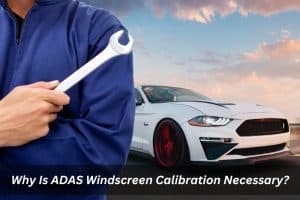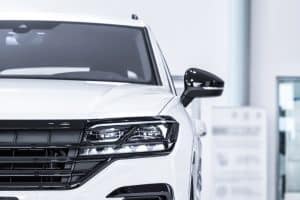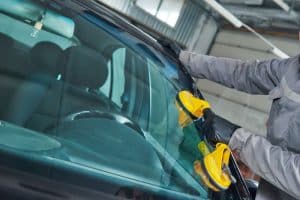Why Is ADAS Windscreen Calibration Necessary?

Imagine cruising down the highway, the open road stretching before you. Suddenly, a car swerves into your lane. In a split second, your car slams on the brakes, avoiding a collision. This near miss could be a reality thanks to Advanced Driver-Assistance Systems (ADAS). These clever features use a network of sensors and cameras to enhance your awareness and intervene in critical situations. But for ADAS to function flawlessly, something crucial sits right in front of it – your windscreen. That’s where ADAS windscreen calibration comes in.
What is ADAS and why is it important?
ADAS is a suite of technologies designed to make driving safer and less stressful. Common features include:
- Automatic Emergency Braking (AEB): Senses an imminent collision and automatically applies the brakes to avoid or mitigate an impact.
- Lane Departure Warning (LDW): Alerts you if you unintentionally stray from your lane without indicating.
- Adaptive Cruise Control (ACC): Maintains a safe distance from the car in front, automatically adjusting your speed.
These are just a few examples, and ADAS technology is constantly evolving. By providing early warnings and even taking corrective actions, it can significantly reduce the risk of accidents.
How does a windscreen play a part in ADAS?
Imagine your car as a high-tech guardian angel, constantly monitoring the road for potential hazards. That’s essentially what ADAS does, and the windscreen acts as its critical window to the world. Here’s a closer look at how it all works:

- Camera with a view: Many ADAS features rely on a camera strategically mounted behind the windscreen. This camera is like the system’s eyes, capturing real-time visual data in high definition. Think of it as a live video feed of the road ahead.
- Beyond the obvious: The camera doesn’t just capture a generic picture. It’s specifically designed to analyse specific elements on the road. Lane markings become digital guides, allowing features like Lane Departure Warning (LDW) to identify when you’re unintentionally straying. Similarly, the camera can detect objects like vehicles and pedestrians, feeding this information to systems like Automatic Emergency Braking (AEB) which can take action to avoid a collision.
- Distance matters: The camera doesn’t just see objects; it measures them. Using advanced image recognition software, it can gauge the distance between your car and the one in front, enabling features like Adaptive Cruise Control (ACC) to maintain a safe following distance.
- Precision is key: All this information gathering relies on a crucial factor – a clear and unobstructed view through the windscreen. The camera’s position is precisely calibrated at the factory to ensure it captures the correct field of view. Any distortion or misalignment can throw off the entire system, potentially leading to inaccurate data and compromised safety features.
When does a windscreen calibration become necessary?
Here’s the catch: the ADAS camera needs a clear and unobstructed view of the road, and its position is precisely calibrated at the factory. Now, imagine replacing your windscreen. Even the slightest misalignment during installation can throw the camera’s angle off-kilter. This might seem insignificant, but for a system that relies on millimetre-perfect accuracy, it can have serious consequences.

Here are some situations where ADAS windscreen calibration becomes necessary:
- Windscreen replacement: This is the most common scenario. Even if the new windscreen is identical to the old one, even a tiny difference in placement can affect the camera’s alignment.
- Windscreen repairs: In some cases, repairs like chip filling might necessitate recalibration, especially if they’re near the camera’s field of view.
- Certain accidents: If your car has been in an accident that impacted the windscreen or camera mounting area, calibration might be needed to ensure proper ADAS function.
What happens if you skip ADAS windscreen calibration?
Think of an uncalibrated ADAS camera like a pair of glasses with the wrong prescription. The information it receives will be skewed, leading to inaccurate data being fed into the ADAS system. Here’s what could happen:
- Delayed warnings: The system might take longer to detect hazards, potentially delaying critical safety interventions like automatic braking.
- Malfunctioning features: In the worst-case scenario, these features could malfunction entirely, leaving you without their protective benefits.
- False positives: A misaligned camera might misinterpret road markings or objects, leading to false alarms and unnecessary driver distraction.
Not only does skipping calibration compromise your safety, but it can also void your car’s warranty in some cases.
Where can you get your ADAS windscreen calibrated?
Now that you understand the importance of ADAS windscreen calibration, the next question is: where do you get it done? Here’s what you need to know:
- Qualified technicians: Look for a reputable windscreen replacement or repair service provider with technicians trained and equipped for ADAS calibration. They’ll not only have the specialist tools and software required for precise adjustments but can also advise you on whether your specific windshield damage qualifies for repair using a resin injection process or necessitates a full replacement to ensure optimal safety and ADAS functionality.
- Calibration during windscreen replacement: When replacing your windscreen, always enquire about ADAS calibration. Many reputable service providers will include it as part of the replacement process.
- Don’t be afraid to ask: If you’re unsure whether your car requires calibration after a repair or accident, don’t hesitate to ask a qualified technician. They can assess the situation and advise you accordingly.
Conclusion
ADAS windscreen calibration is a vital step in maintaining your car’s safety features. By ensuring your camera has a clear and accurate view of the road, you’re giving yourself and your passengers the best possible protection on the road. Remember, a properly calibrated system is like having an extra pair of eyes on the road, helping you navigate the world safely and confidently.
But before you can worry about calibration, you need a high-quality windscreen replacement that meets all the manufacturer’s specifications. At Windscreen Replacers, we specialise in windscreen replacements using top-of-the-line materials and expert installation techniques. Our technicians are committed to delivering a flawless finish, ensuring your visibility is never compromised.
Don’t settle for a chipped or cracked windscreen that could potentially impact your safety and obscure the view of your ADAS camera. Contact us today for a free quote and experience the difference a clear view can make. We’ll get you back on the road with confidence, ready to enjoy the peace of mind that comes with a pristine windscreen.
